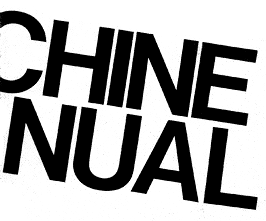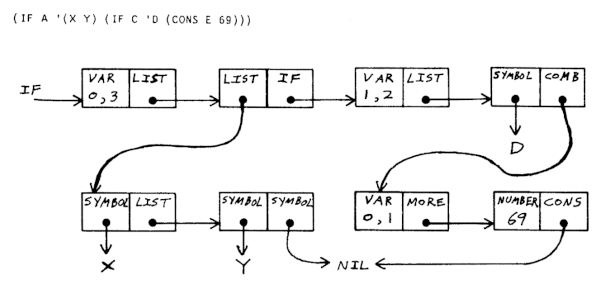Functional languages rely on first-class functions, anonymous functions and immutability.

A programming paradigm in which function definitions are trees of expressions that map values to other values, rather than a sequence of imperative statements.
Fizzbuzz, in Heol Lisp.
(define print-ln (lambda (s) (and (print s) (print '\n)))) (define fizzbuzz (lambda (n f b) (if (< n 101) (if (and (eq? f 3) (eq? b 5)) (and (print-ln 'FizzBuzz) (fizzbuzz (+ n 1) 1 1)) (if (eq? f 3) (and (print-ln 'Fizz) (fizzbuzz (+ n 1) 1 (+ b 1))) (if (eq? b 5) (and (print-ln 'Buzz) (fizzbuzz (+ n 1) (+ f 1) 1)) (and (print-ln n) (fizzbuzz (+ n 1) (+ f 1) (+ b 1)))))) ()))) (fizzbuzz 1 1 1)
Fizzbuzz, in LISP 1.5.
(LETREC main (main λ (INPUT) (loop (QUOTE 1) (QUOTE 100))) (loop λ (x y v) (IF (LEQ x y) (loop (+ x (QUOTE 1)) y (fizzbuzz x)) (QUOTE Completed))) (fizzbuzz λ (n) (IF (EQ (% n (QUOTE 15)) (QUOTE 0)) (WRITE (QUOTE FizzBuzz)) (IF (EQ (% n (QUOTE 3)) (QUOTE 0)) (WRITE (QUOTE Fizz)) (IF (EQ (% n (QUOTE 5)) (QUOTE 0)) (WRITE (QUOTE Buzz)) (WRITE n))))))
A common trait of all dialects of LISP is the S-expression.
In Lisp, a pair of parentheses indicates one step of calculation, operations use the prefix notation.

Programs in Lisp are made of symbols that are nested into trees using cons cells. A number is a signed integer represented by a sequence of decimal digits, optionally preceded by a sign.
45 +137 -27
A symbol is word represented by a sequence of characters, it cannot begin with a number or a sign, although these may appear later in a symbol.
Hello Hello-world x32
A cons cell is an allocation of memory made of two parts, a value(car) and a pointer(cdr), the cdr can point to another cell.
(123) (hello 45) (foo (bar baz))

Gödel's bag, Gödel's bag,
Gödel's bag.
Bägel is a programming language where functions return multisets(bags) and compose by multiplication. Every item is a bag of factors and every function a multiplicative transformation. Think Fractran, without the rule-searching of rewriting, or a strange Lisp in which cons cells are unordered lists.
In this mirror world, order does not matter, only presence and reduction.
Primitives
Parentheses denotes a bag, which may contain items or other bags. The final bag left after the reduction is the output of a program.
; This is a comment () ; Empty(1), identity (2) ; 2 (2 ()) ; 2 (2 (2 3)) ; 12
The order of items in a bag does not matter.
((2 3) 2) ; 12 (3 (2 ())) ; 6
Items in a bag are written as unreduced fractions. Non-numeric symbols are bound to prime factors beyond the highest utilized factor in a program.
(125 1/5) ; 5^3 * 1/5 = 5^2 (2 3/2) ; 2 * 3/2 = 3 (5 1/5) ; () fizz/2^3 buzz/3^5 2^4 ; 2 fizz buzz/3^5
Intersection
The intersection operator (% a b c..) returns the GCD of all arguments.
(% 6 15) ; 2 * [3] % [3] * 5 = 3 (% 6 7) ; 2 * 3 % 7 = Empty[1] (2 (% 6 2)) ; 2 * (2 * 3 % 3) = 2^2
This is the only building block needed for conditionals, the intersection yields a register mask that can be used to reduce the bag one way or another.
(% 2 (x 5/2)) ; if x2 then 5, otherwise () (% 6 (x 5/6)) ; if x2 && x3 then 5, otherwise () (% x (x 5/11)) ; if !x11 then x, otherwise ()
Function
The function operator (λ fn) tries to apply a transformation until it stabilizes, in other words, until no more reduction can occur.
(λ 3/2 (2 2)) ; (2 3), (3 3). (λ 5/3 (3 3 3 7)) ; (3 3 5 7), (3 5 5 7), (5 5 5 7). (% 2 (λ 1/2 2^5)) ; 2 for odd, () for even.
For example, to count until 5, a fraction containing the boundary of the iteration can halt the transformation.
(λ 2/1 3/2^5)
(λ 2/1 3/2^4) (λ 2/1 3/2^3) (λ 2/1 3/2^2) (λ 2/1 3/2^1) 3
The named operator (name λ fn) allows for recursion and for symbols to operate as functions.
(double λ 9/2)
2^2 3 double/3 2^2 (λ 9/2) 2 3^2 (λ 9/2) 3^4
Implementation and details will be added soon, I wrote all this, as if in a fever, on the night of Halloween.
incoming: concatenative